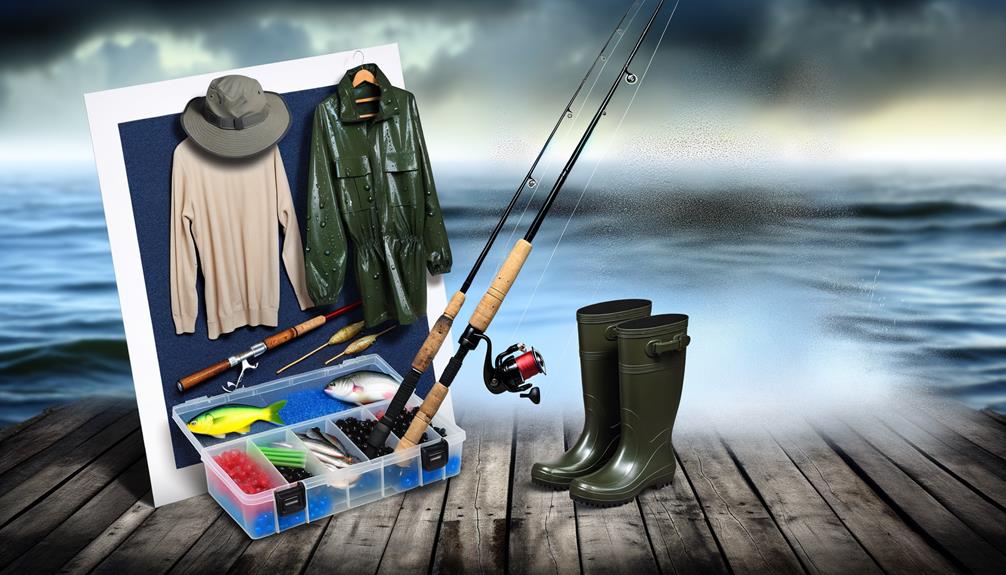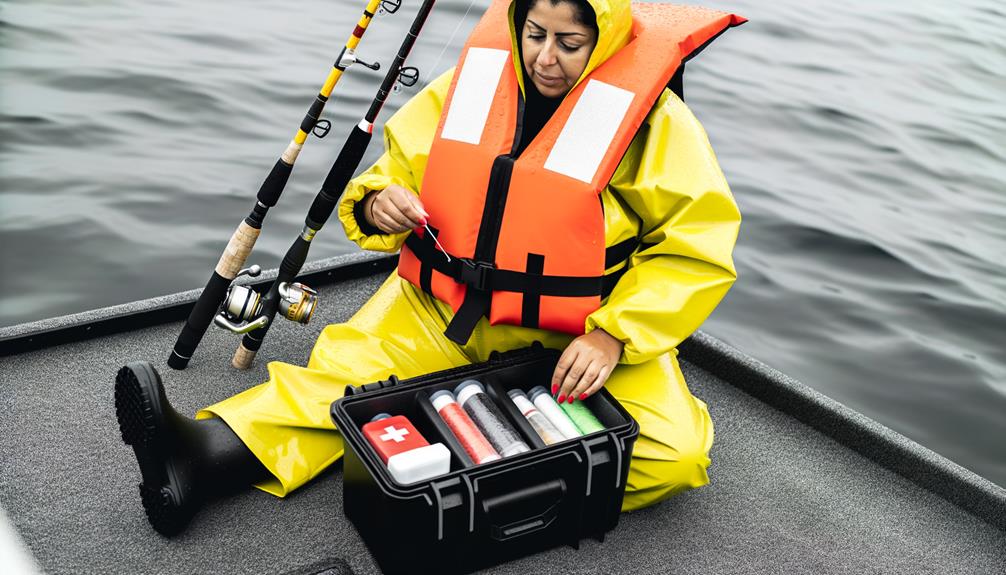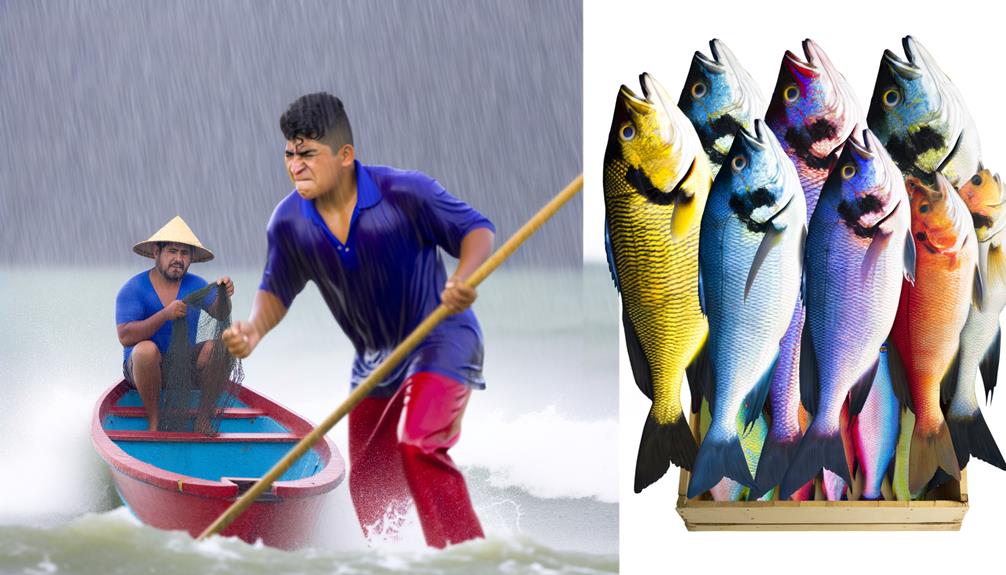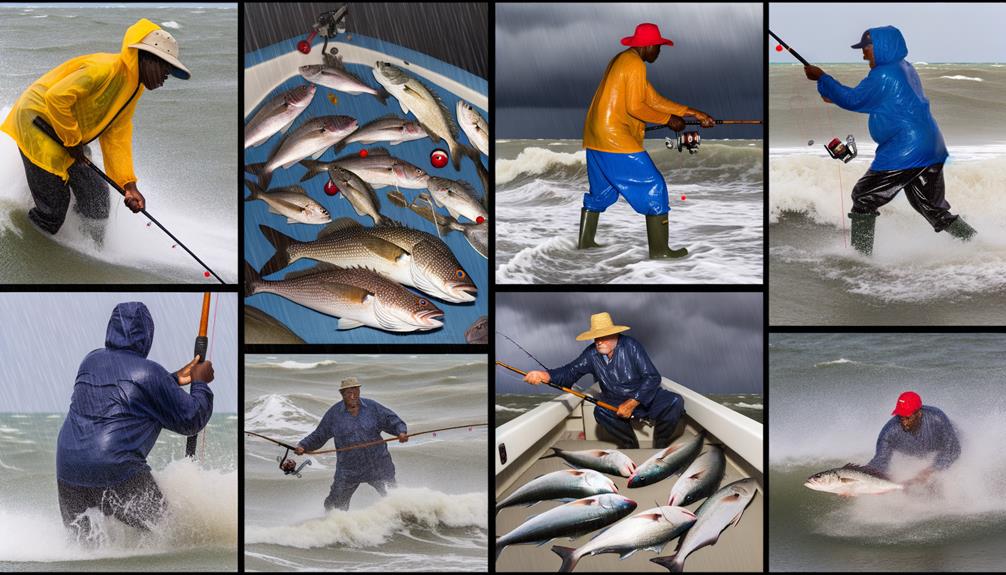The impact of rainfall on saltwater fishing is a topic that continues to invite a plethora of debates among anglers, marine biologists, and weather experts.
While the rain can bring about certain changes in the aquatic environment, like altering water temperatures and oxygen levels, its overall effect on fishing success remains somewhat elusive.
Factors such as the intensity of the rain, wind patterns, and even the species of fish in question, can all contribute to the outcome. Therefore, a nuanced understanding of these dynamics can provide invaluable insights for those wishing to optimize their saltwater fishing experiences in the rain.
Key Takeaways
- Rain affects saltwater fishing by altering water temperatures and oxygen levels, which influences fish behavior and distribution.
- Certain species like snook, baby tarpon, and redfish show increased activity post-rain, making rain a potentially beneficial fishing time.
- Essential gear for rainy saltwater fishing includes waterproof apparel and scent-driven lures, with proper bait selection crucial for success.
- Although rain can enhance fishing productivity, safety risks such as lightning storms necessitate regular weather monitoring and caution.
Understanding Rain's Impact on Saltwater Fish
While it may seem counterintuitive, the natural phenomenon of rain can significantly impact the behavior and distribution of fish in saltwater environments, with factors such as water muddiness, temperature fluctuations, and oxygen levels playing pivotal roles.
The act of fishing in the rain can indeed be a complex ordeal, as the rain affect on water conditions is multifaceted. When rain muddies the waters, it can act as a deterrent for fish, altering their normal biting behavior. This effect is particularly pronounced in bays, especially if there is heavy rain upstream. The direction and volume of the wind during a rainfall also contribute to the distribution and activity of fish, oftentimes in unpredictable ways.
On a positive note, rain can lower the water temperature and increase oxygen levels, which can stimulate and improve fishing conditions in certain saltwater areas. However, these beneficial effects are not universal and can vary based on the intensity and duration of the rainfall.
Understanding these intricacies of how rain influences saltwater environments is crucial for developing successful fishing strategies. It allows anglers to adapt to varying conditions, emphasizing the importance of knowledge and preparation in the art of fishing.
Ideal Fish Species for Rainy Conditions
In the realm of saltwater fishing, certain species such as snook, baby tarpon, and redfish have been observed to exhibit increased activity in rainy conditions, positioning them as ideal targets for anglers. These species show distinct behavioural changes in response to rain, making them more accessible and easier to catch. This is particularly true in summer, when snook and baby tarpon are known to be active post-storm.
Redfish, notably, have been known to bite well in low-light conditions typical of rainy weather. This behavioural trait can be leveraged by anglers to optimize their fishing strategies.
Understanding the nuances of fish behaviour in rainy conditions can provide a strategic advantage. Here are some key points to consider:
- Snook and baby tarpon tend to be more active post-rain, particularly in summer.
- Redfish bite well in low-light conditions, such as during the rain.
- Rain can make the water muddy, which may attract fish looking for food.
In essence, with the right knowledge and approach, rainy conditions can provide an excellent opportunity to catch certain saltwater species such as snook and redfish.
Essential Gear for Rainy Saltwater Fishing

Equipping oneself with the appropriate rain gear is a critical aspect of ensuring comfort and success while engaging in saltwater fishing during rainy conditions. To avert the discomfort and potential health risks associated with exposure to the elements, waterproof jacket and pants are indispensable. Lightweight rain jackets or windbreakers, in particular, offer the dual advantage of mobility and protection.
In addition to the right clothing, choosing the appropriate bait is also paramount. Scent-driven lures or live bait can be highly effective in attracting fish in the murky waters that often accompany rain.
The table below provides a succinct summary of the essential gear for rainy saltwater fishing:
| Essential Gear | Purpose |
|---|---|
| Waterproof jacket and pants | To stay dry and comfortable |
| Lightweight rain jackets or windbreakers | For mobility and protection |
| Scent-driven lures or live bait | To attract fish in murky waters |
Timing: Before, During, and After Rain
Beyond selecting the right gear for rainy saltwater fishing, understanding the timing of your fishing trip—namely before, during, and after the rain—is equally important for a successful catch. The barometric pressure and temperature changes that occur before a rainstorm often trigger fish to feed, making this an opportune time to cast your line. Using scented lures enhances the chances of attracting fish during this pre-rain period.
However, fishing during rainfall can pose safety risks, such as lightning storms, and is, therefore, not recommended. After the rain, conditions often settle, creating a calm environment that is ideal for fishing. This is when predator fish like snook become active, attracted by the prey swept into the saltwater by the heavy rains.
- Before rain: Fish are triggered to feed due to changes in temperature and barometric pressure. Scented lures are effective.
- During rain: Due to safety risks primarily from lightning storms, this period is not ideal for fishing.
- After rain: Conditions are calm, and predator fish are active, attracted by prey swept into the water.
Safety Precautions for Rainy Day Fishing

Navigating the inherent weather-related risks associated with rainy day fishing requires a comprehensive understanding of meteorological patterns and safety measures. Essential gear, timely weather updates, and a keen awareness of changes in atmospheric conditions significantly mitigate these risks.
This analysis will focus on the systematic identification of weather-related risks and a detailed checklist of essential gear to ensure safety in saltwater fishing under rainy conditions.
Weather-Related Risks
A significant proportion of the risks associated with fishing in the rain are weather-related, with lightning storms posing a particularly hazardous threat to safety. Even light rain can escalate into severe weather conditions rapidly, endangering those who are unprepared.
To mitigate these weather-related risks, anglers should:
- Regularly monitor weather updates and be particularly cautious of incoming storms.
- Prioritize evacuating the water if a storm is approaching.
- Understand the potential dangers associated with fishing in the rain.
A comprehensive grasp of these safety precautions contributes to a secure and enjoyable fishing experience, despite inclement weather. Ignoring these risks not only jeopardizes personal safety but also compromises the sense of belonging we all crave in our shared fishing community.
Essential Gear Checklist
While understanding the potential dangers of fishing in inclement weather is crucial, equipping oneself with the right gear is another key factor in ensuring both safety and success during rainy day saltwater fishing expeditions. Careful selection of waterproof attire, such as lightweight rain jackets or windbreakers, can provide both mobility and protection.
Furthermore, using scent-driven lures, like the Berkley Gulp Shrimp, can significantly improve your prospects of attracting fish in murky water conditions. Below is a summary of essential gear for rainy day saltwater fishing:
| Gear Type | Examples |
|---|---|
| Waterproof attire | Lightweight rain jackets, waterproof pants |
| Scent-driven lures | Berkley Gulp Shrimp, live bait |
Impact of Rain on Fish Feeding Patterns
Rain significantly influences the behavior of both predator and prey fish in the saltwater environment, impacting their feeding patterns.
The introduction of freshwater into the marine ecosystem, often through discharge structures, creates new dynamics to which fish must adapt.
Understanding these changes, bolstered by the weather's role in fish distribution, is crucial to successful angling in rainy conditions.
Rain Influence on Predation
Impacted significantly by changes in temperature and pressure, fish exhibit more active feeding behavior prior to a rainstorm, a phenomenon that has crucial implications for both their survival and predation strategies. As the storm passes, the rain can wash insects and other prey into the water, attracting fish to feed.
- Rain-induced increase in water turbidity provides an optimal environment for predator fish to ambush prey.
- The aggressive and opportunistic feeding behavior of fish during and after rain provides a unique predation opportunity.
- Understanding these patterns can help anglers target active feeding zones effectively.
These observations help us appreciate the intricate balance of the aquatic ecosystem and the influential role of rain on fish feeding and predation strategies.
Weather's Role in Distribution
In assessing the impact of weather on fish distribution, it becomes clear that changes in temperature and pressure, indicative of an impending storm, act as catalysts for fish to feed, thereby enhancing the productivity of fishing just before the onset of rain or a storm. This can significantly affect fishing, including sight fishing.
| Weather Condition | Effect on Fish Feeding |
|---|---|
| Temperature Change | Triggers Feeding |
| Impending Storm | Enhances Productivity |
| Rainfall | Attracts Predator Fish |
| Heavy Rain | Increases Prey Availability |
| Post-Storm Calm | Ideal for Fishing |
Monitoring weather changes and observing fish behavior post-rain can help anglers adapt their strategies for successful saltwater fishing. Post-storm conditions are calm and ideal for fishing, with species like snook and baby tarpon being particularly active.
Pros and Cons of Saltwater Fishing in Rain

While the prospect of saltwater fishing in the rain can be daunting to some, it presents a unique set of advantages and challenges that significantly influence the success of a fishing expedition. One prime advantage is that rain can lower water temperature and increase oxygen levels. This shift in water conditions can enhance the activity of certain fish species, such as the Black Drum, making them more likely to bite.
However, there are potential drawbacks as well. Heavy rainfall can cause waters to muddy, which may deter fish and decrease bite success. Additionally, if the rain is severe enough to alter salinity levels in bays due to upstream runoff, the behavior of saltwater species can be unpredictably affected.
In summary, the pros and cons of saltwater fishing in the rain are:
- Improved fishing conditions due to increased oxygen levels and cooler water temperatures, which can stimulate the activity of fish like the Black Drum.
- Potential decrease in fish attraction due to muddied waters.
- Unpredictable fish behavior caused by altered salinity levels.
Ultimately, how conditions are usually experienced will depend on the specific circumstances of the rainfall and the response of the local fish population.
Rainy Day Fishing Strategies
Given the potential challenges and opportunities presented by saltwater fishing in the rain, it is imperative to strategize effectively to maximize potential success. The barometric shifts and temperature changes associated with an impending storm trigger fish to feed, making fishing before a storm particularly fruitful. As the water becomes turbulent, fish tend to seek food, increasing the chances for a successful catch.
In the aftermath of rainfall, the mix of freshwater and saltwater draws predator fish downstream of discharge structures. This is a prime time for fishing, with species like snook and baby tarpon becoming notably active. Heavy rain also sweeps prey into the saltwater, creating an opportunistic feeding frenzy for predator fish.
To capitalize on these conditions, anglers should employ lures with high sink rates. These lures can effectively combat the heavy currents during and following a rainstorm, reaching the depths where fish may be feeding. By understanding the behavioral changes of fish during varying weather conditions, and aligning strategies accordingly, one can enhance their chances of a rewarding catch, even in the rain.
Case Studies: Successful Rainy Fishing Expeditions

Documented instances of successful rainy fishing expeditions provide insightful examples of how strategic adaptations to inclement weather conditions can yield fruitful results. Anglers often modify their strategies, acknowledging the influence of rain on fish behavior and the environment. The best fishing spots during rain often include areas where freshwater meets saltwater, such as discharge structures.
In one case study, a group of anglers reported successful catches of redfish and speckled trout during light rain showers. They utilized scent-driven lures like Berkley Gulp Shrimp, which attracted the fish effectively despite the reduced visibility. Another case study revealed the effectiveness of fishing near discharge structures post-rain, resulting in a productive catch.
Key strategies from these case studies include:
- Using live bait or scent-driven lures to attract fish
- Adapting fishing techniques to target fish in heavy currents
- Identifying and utilizing the best fishing spots influenced by rain
These strategies demonstrate that, with careful planning and adaptability, rainy conditions can enhance, rather than hinder, saltwater fishing expeditions. Such success stories foster a sense of belonging among anglers, reinforcing the belief that they can conquer any weather conditions.
Frequently Asked Questions
Do Salt Water Fish Bite in the Rain?
Yes, saltwater fish do bite in the rain. The rain's impact can alter water conditions and stimulate fish activity. Adapting fishing techniques, such as using scent-driven lures, can increase catch rates in rainy conditions.
Is It Worth Fishing in the Rain?
Yes, fishing in the rain can be beneficial. Rain stimulates feeding activity, providing an advantageous environment for anglers. However, it's crucial to wear appropriate rainwear and protect equipment to ensure a productive and comfortable experience.
Are Fish More Likely to Bite in the Rain?
Yes, fish are more likely to bite in the rain. Rainy behavior influences their feeding habits due to changes in temperature and pressure, increased prey activity, and reduced visibility, stimulating more active feeding.
What Do Fish Do When It Rains in the Ocean?
Rainfall impact on oceanic behavior stimulates fish activity. As rain washes additional food sources into the ocean, fish feed more aggressively. However, changes in water temperature and oxygen levels may alter their behavior.
Conclusion
In conclusion, rain's influence on saltwater fishing is multifaceted, affecting both the water conditions and fish behavior. While it may present challenges such as muddied waters, it also offers unique opportunities by altering fish feeding patterns.
Success in these conditions hinges on strategic adjustments, the use of appropriate gear, and diligent safety precautions. Therefore, understanding and adapting to the diverse impacts of rain can enhance the angler's ability to effectively fish in saltwater during rainy conditions.


